Introduction
Mobile apps have become an integral part of our daily lives, offering convenience, entertainment, and productivity at our fingertips. As the app market continues to grow exponentially, building a successful mobile app requires careful planning and execution. In this step-by-step guide, we will explore the key factors to consider during the development process and provide actionable tips to help you create a mobile app that stands out from the competition.
1. Market Research and Idea Validation
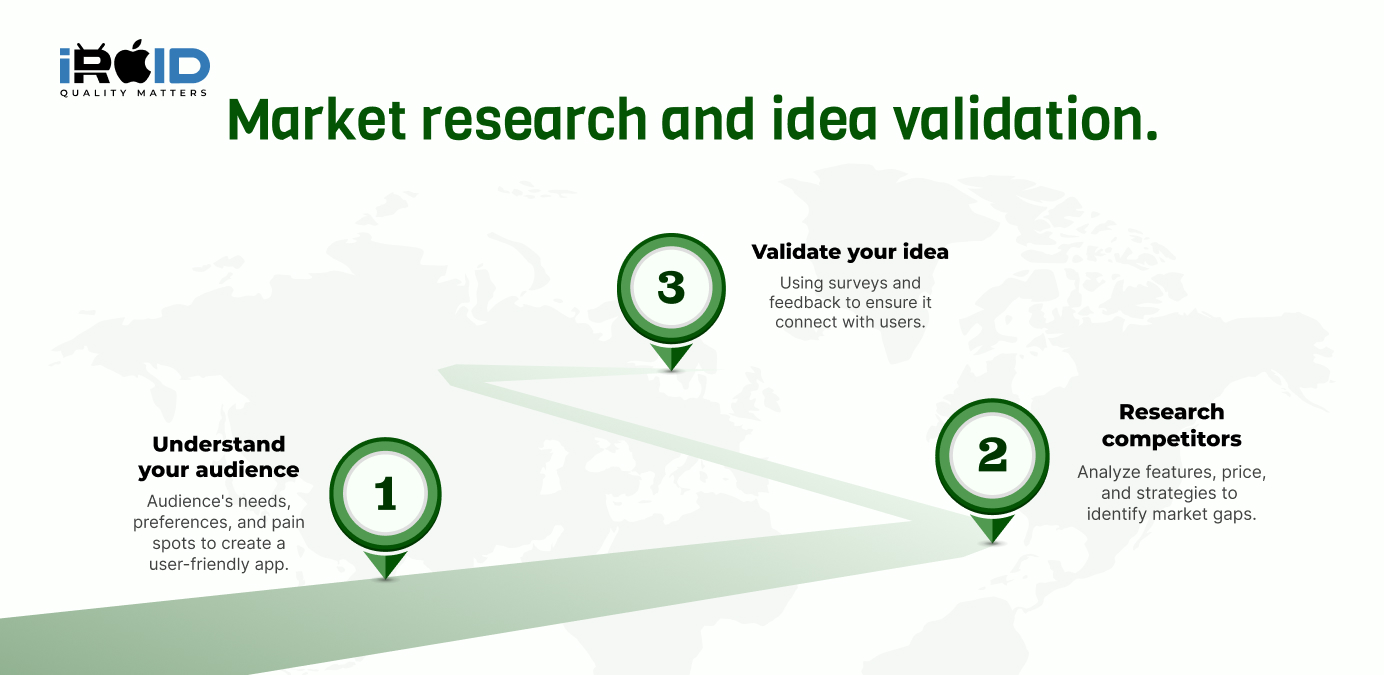
A. Identifying the target audience
Before diving into app development, it's crucial to identify your target audience. Understanding their needs, preferences, and pain points will allow you to tailor your app to their specific requirements. Conducting thorough market research, analysing demographics, and studying user behaviour will enable you to create a user-centric app that addresses real-life problems.
B. Analysing competitors
Analysing the competition is a critical step in building a successful mobile app. By studying your competitors' strengths and weaknesses, you can identify gaps in the market and develop unique selling points for your app. Analyse their features, user interface, pricing, and marketing strategies to gain insights into what works and what doesn't.
C. Validating app concept through surveys and feedback
Once you have identified your target audience and analysed the competition, it's essential to validate your app concept. Conduct surveys, gather feedback from potential users, and perform usability testing to ensure that your app idea resonates with your target market. This validation process will provide valuable insights and help you refine your app concept before proceeding further.
2. Define Objectives and Goals
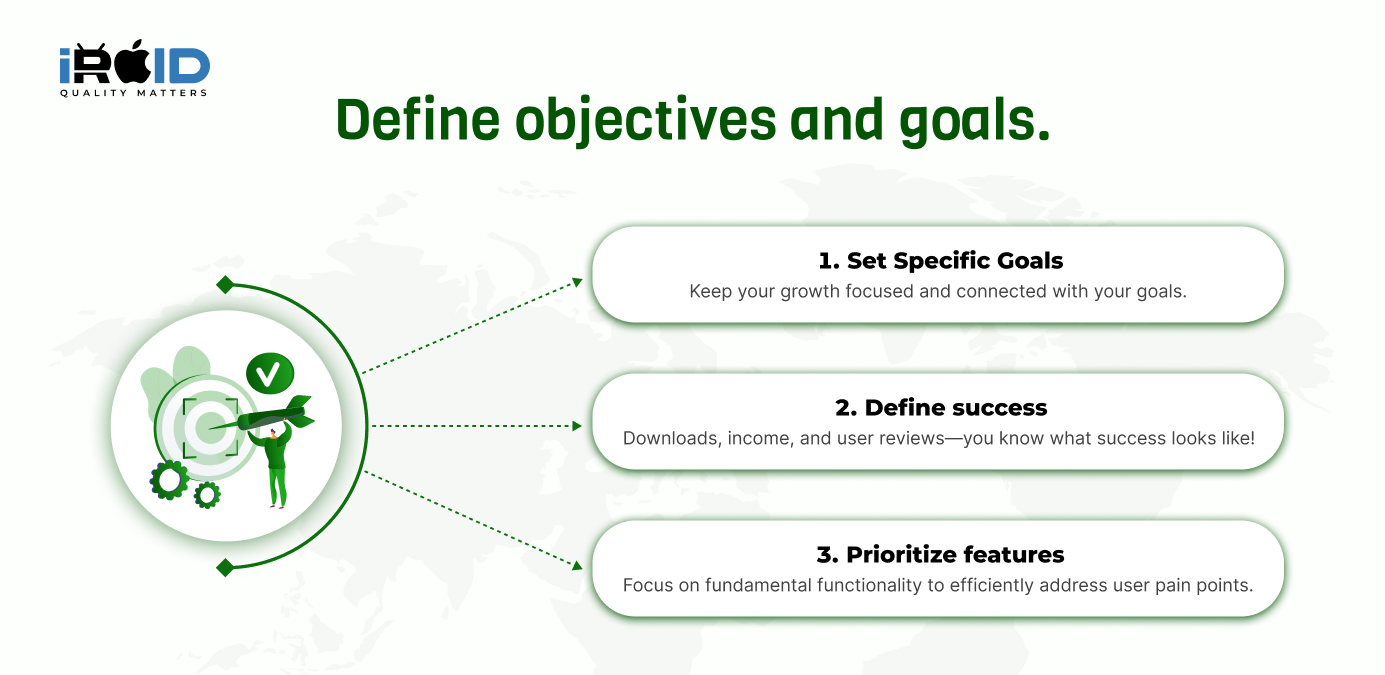
A. Establishing clear project objectives
Clearly defining project objectives is vital to staying focused and ensuring that your development process aligns with your overall vision. These objectives serve as guiding principles throughout the app development journey and provide a framework for decision-making.
B. Defining success criteria
Alongside setting project objectives, it is crucial to define success criteria for your app. Whether it is reaching a specific number of downloads, achieving a certain revenue target, or receiving positive user reviews, clearly defining your success criteria will help you assess the effectiveness of your mobile app and make necessary improvements.
C. Outlining key features and functionality
Outlining the key features and functionality of your app is a crucial step in building a successful mobile app. Identify the core functionalities that address your target audience's pain points and prioritise them. This allows you to deliver a streamlined user experience without overwhelming users with unnecessary features.
3. Wireframing and Design
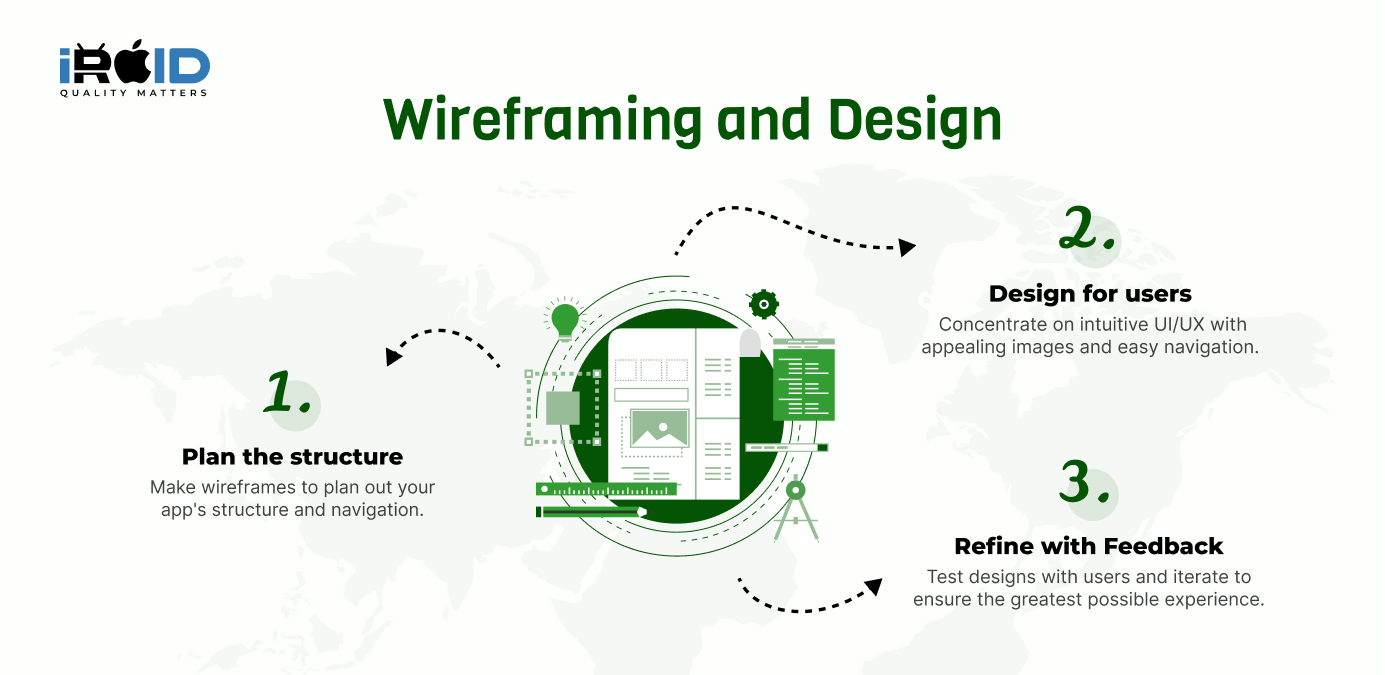
A. Creating a basic app structure
Wireframing is a visual representation of your app's layout and navigation flow. It helps you outline the skeletal structure of your app and determine the optimal user journey. Start with simple sketches or use digital tools to create wireframes that illustrate the key screens and their connections.
B. Designing user interface (UI) and user experience (UX)
Once you have the basic app structure in place, it's time to focus on designing the user interface (UI) and user experience (UX). Good UI/UX design is crucial for ensuring user engagement and satisfaction. Pay attention to colour schemes, typography, visual elements, and intuitive navigation to create an aesthetically pleasing and user-friendly app.
C. Gathering feedback on initial designs
After creating the initial design, gather feedback from potential users and stakeholders. Conduct usability testing, focus groups, or online surveys to gauge their reactions and suggestions for improvement. This iterative feedback loop helps refine your app's design based on real user inputs.
4. Technical Feasibility Assessment
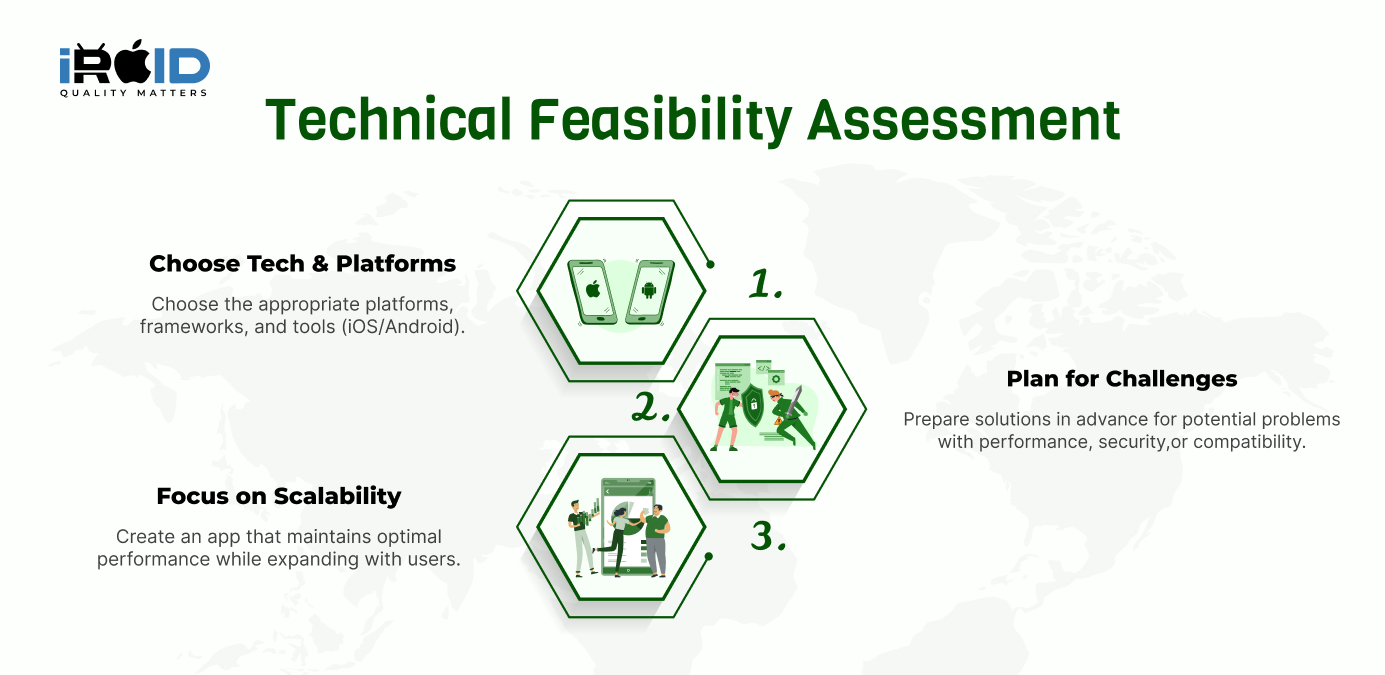
A. Identifying required technologies and platforms
Before diving into development, assess the technical feasibility of your app. Determine the required technologies, frameworks, and programming languages based on the features and functionality you have outlined. Also, consider the target platforms, such as iOS or Android, and ensure compatibility with the respective technology stacks.
B. Evaluating potential challenges and solutions
During the technical feasibility assessment, it's important to anticipate potential challenges that may arise during the development process. This includes constraints related to device compatibility, performance optimization, security, or third-party integrations. Identify these challenges and brainstorm solutions to mitigate them.
C. Ensuring scalability and performance considerations
Consider the scalability and performance aspects of your app early in the process. Evaluate your app's architecture and determine whether it can handle increasing user loads and data traffic. Implement performance optimization techniques, such as caching, data compression, and minimising network requests, to ensure a smooth and responsive user experience.
5. Software Development
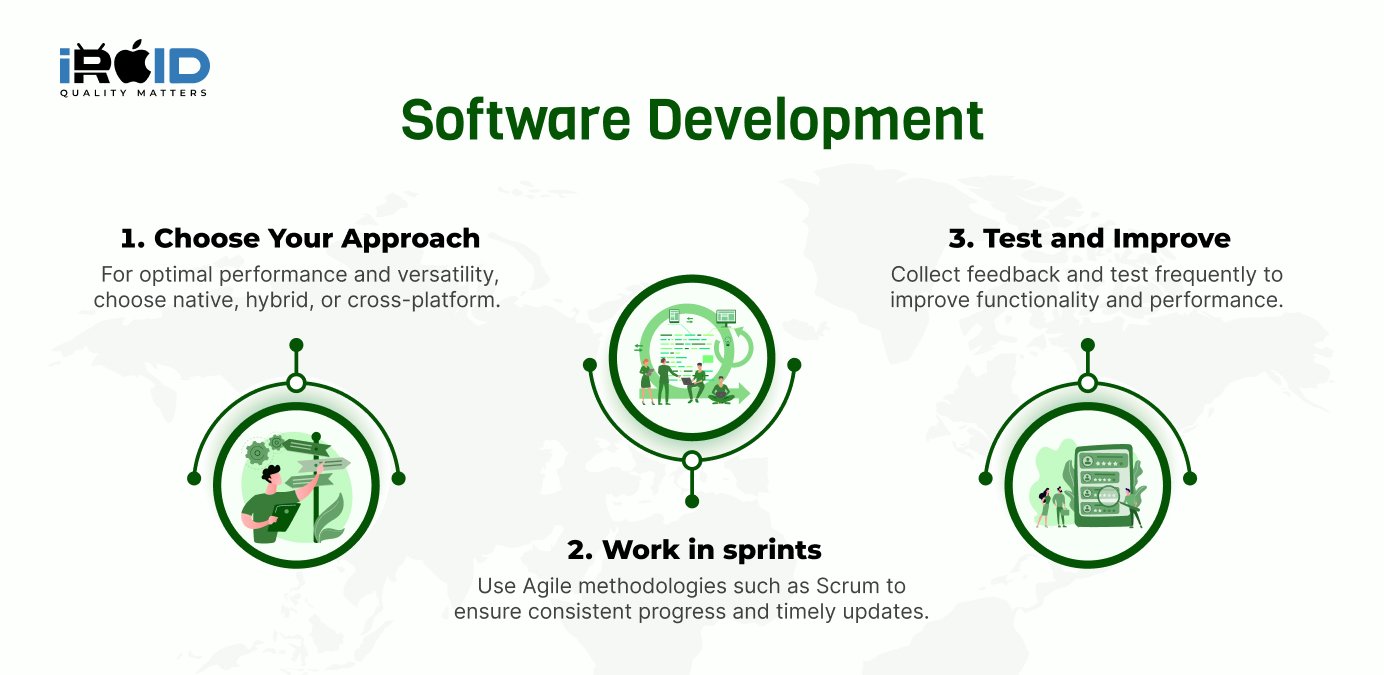
A. Choosing the right development approach (native, hybrid, or cross-platform)
Choosing the right development approach is crucial for the success of your mobile app. Native development offers the best performance and user experience but may require separate development for each platform. Hybrid development allows for cross-platform compatibility but may sacrifice certain performance aspects. Cross-platform frameworks combine the benefits of native and hybrid approaches, striking a balance between performance and code reusability.
B. Breaking down development into sprints or iterations
Divide your development process into smaller sprints or iterations to ensure steady progress and timely deliverables. Agile methodologies, such as Scrum or Kanban, can be effective in managing the development process efficiently. Prioritise features, set realistic timelines, and conduct regular progress meetings to keep the development on track.
C. Integrating feedback and conducting regular testing
Throughout the development process, actively seek feedback from stakeholders and potential users. Integrate their feedback into your app's development, ensuring that user needs and preferences are met. Conduct regular testing, including functional testing, performance testing, and security testing, to identify and rectify issues early on.
6. Testing
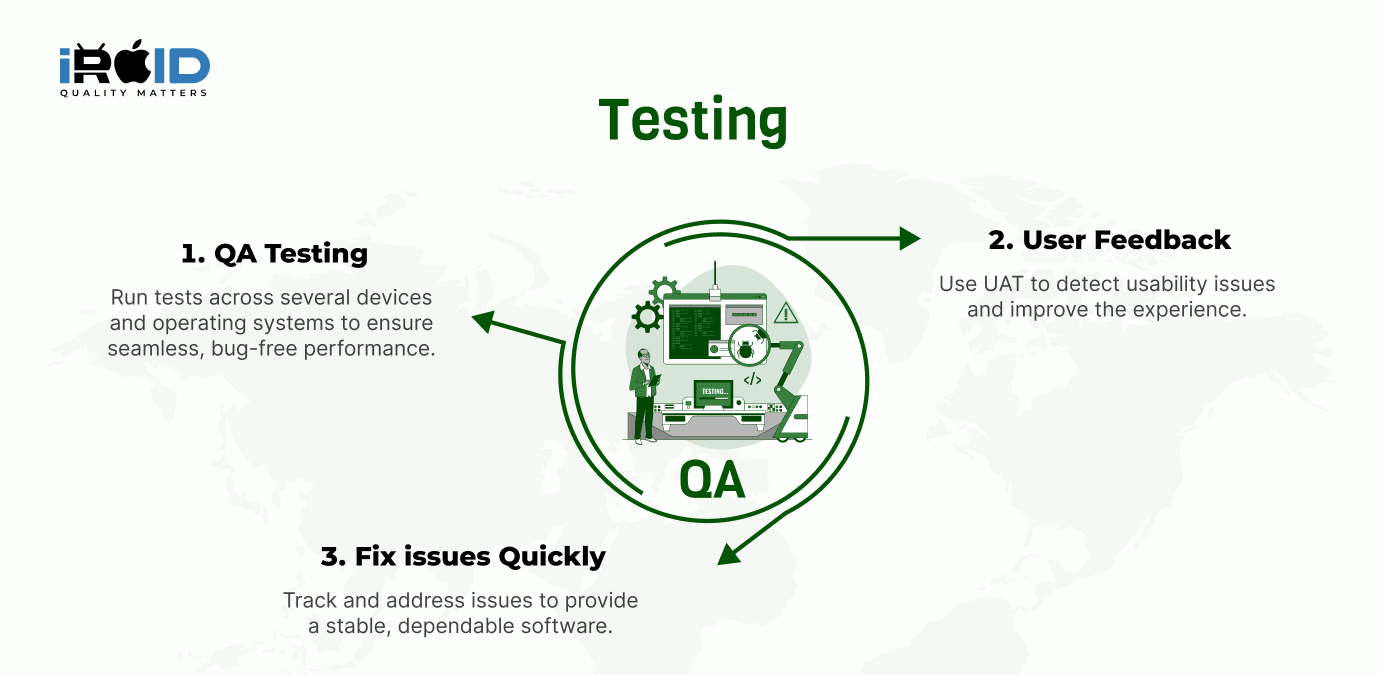
A. Conducting thorough quality assurance testing
Comprehensive quality assurance testing is crucial to ensuring a bug-free and polished app. Test your app across various devices, screen sizes, and operating systems to identify and fix any compatibility issues. Perform functional testing to ensure that all app features work as intended and conduct regression testing to guarantee that existing functionality remains uncompromised.
B. User acceptance testing (UAT)
User acceptance testing (UAT) involves involving real users to test the app and provide feedback. This allows you to identify any usability issues or gaps in user expectations. Incorporate user feedback to make necessary modifications, ensuring a seamless user experience.
C. Identifying and resolving bugs and issues
During testing, it is inevitable to encounter bugs and issues. Maintain a robust bug tracking system to capture and prioritise these issues. Swiftly address them, ensuring that your app is stable and reliable before deployment.
7. Deployment
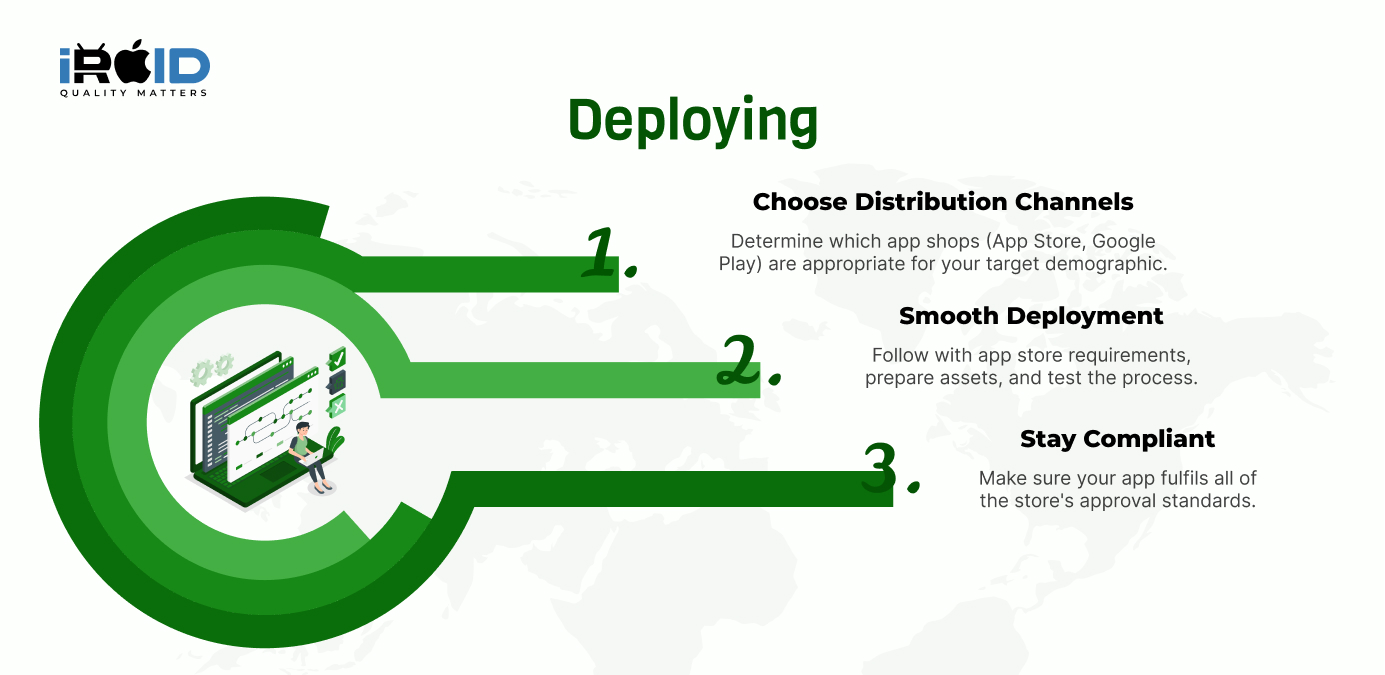
A. Selecting the appropriate app distribution channels (App Store, Google Play, etc.)
Once your app is ready, it's time to deploy it to the appropriate app distribution channels. Consider factors such as your target audience, platform popularity, and revenue models when selecting app stores like App Store or Google Play.
B. Implementing a smooth deployment process
Ensure a smooth deployment process by following the guidelines set by the chosen app stores. Prepare all necessary app assets, including descriptions, screenshots, and app icons. Test the deployment process thoroughly to avoid any last-minute hiccups.
C. Ensuring compliance with app store guidelines
Adhere to the app store guidelines and policies to avoid rejection or removal of your app. Familiarise yourself with the guidelines specific to each app store to ensure compliance with their requirements regarding content, privacy, and security.
8. Marketing and Promotion
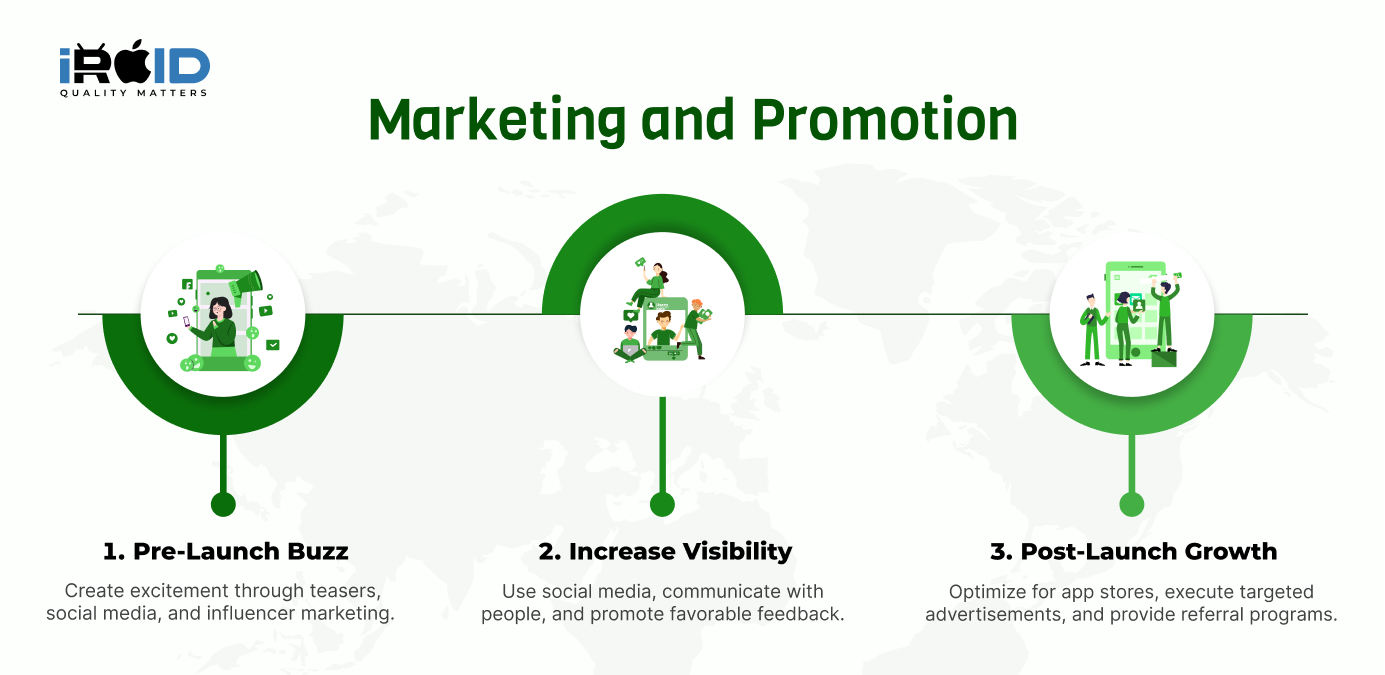
A. Developing a pre-launch marketing strategy
Before launching your app, develop a robust pre-launch marketing strategy. Create a buzz around your app with teasers, promotional campaigns, and sneak peeks. Leverage social media platforms, email marketing, influencers, and press releases to generate anticipation and build an audience.
B. Leveraging social media and other promotional channels
Once your app is launched, continue leveraging social media and other promotional channels to reach a wider audience. Engage with potential users, respond to queries, and encourage positive reviews. Collaborate with influencers or relevant industry partners to extend your app's reach.
C. Post-launch marketing and user acquisition strategies
Constantly monitor user engagement, app metrics, and feedback after the launch. Develop post-launch marketing strategies, including targeted advertising campaigns, app store optimization (ASO), and referral programs. Regularly analyse user acquisition channels and refine your marketing efforts accordingly.
9. User Feedback and Iterative Improvements
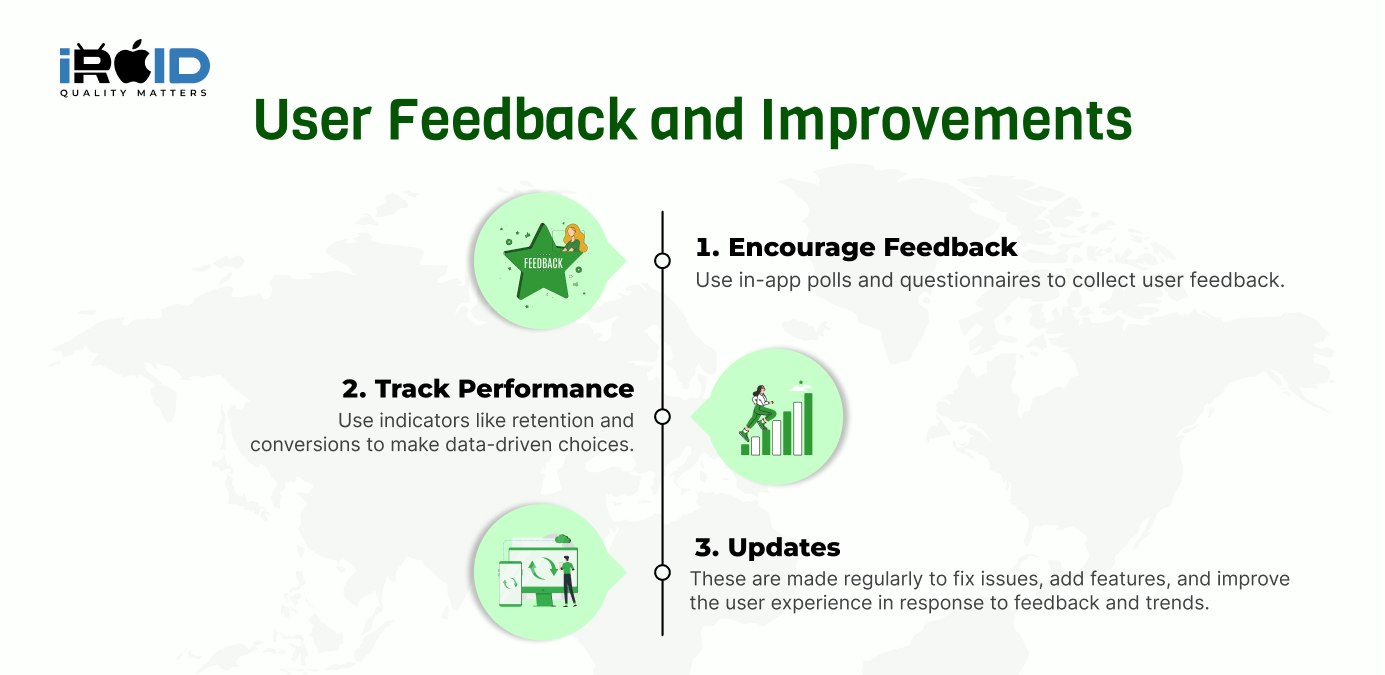
A. Encouraging user feedback
Promote a culture of feedback by actively encouraging users to provide their insights and suggestions. Implement mechanisms within your app, such as feedback forms or in-app surveys, that make it easy for users to share their thoughts. Actively listen to user feedback and consider incorporating valuable suggestions into future updates.
B. Analysing app performance metrics
Analyse app performance metrics, such as user retention, session duration, and conversion rates, to gain insights into app usage patterns. Identify areas that require improvement or optimization based on these metrics. Utilise analytics tools to track user behaviour and make data-driven decisions.
C. Planning and implementing regular updates
Regularly update your app to address bugs, introduce new features, and improve user experience. Plan updates based on user feedback, performance metrics, and market trends. Communicate these updates to your users to maintain engagement and demonstrate your commitment to continuous improvement.
10. Maintenance and Support
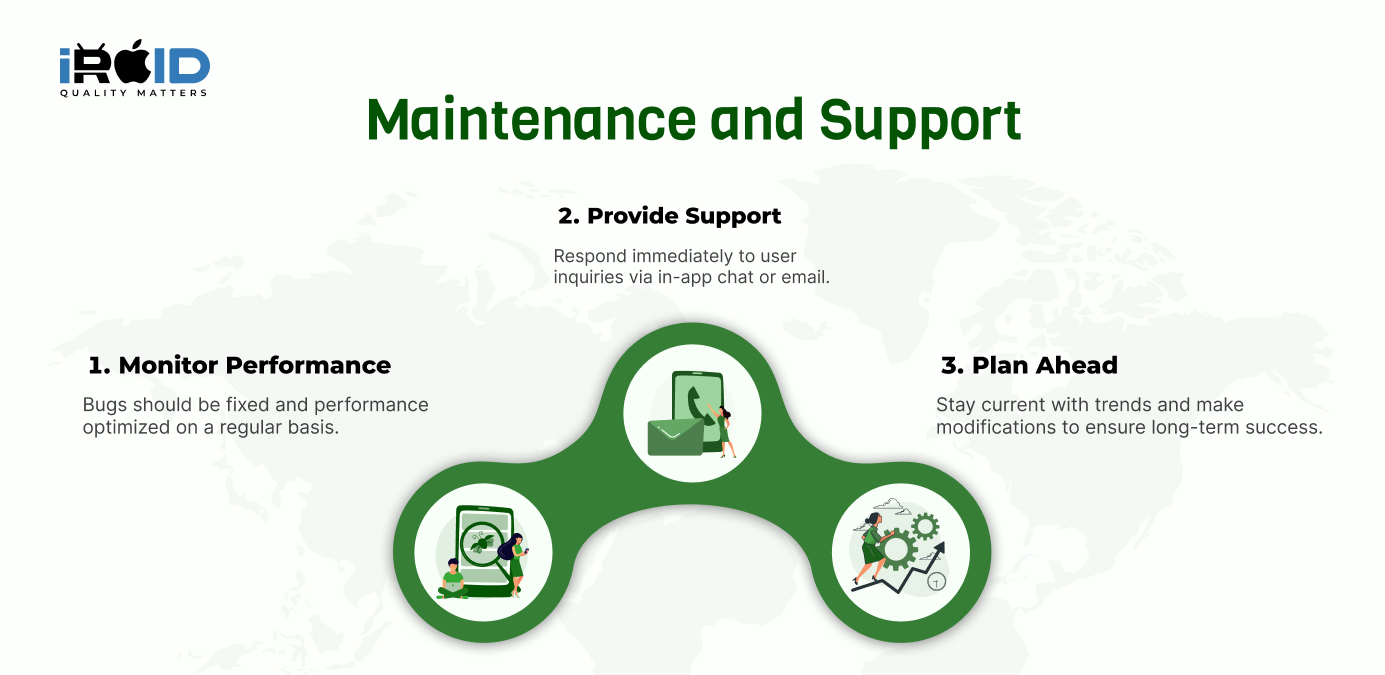
A. Monitoring app performance and addressing issues promptly
Monitor your app's performance regularly to ensure that it meets the desired standards. Proactively address any performance issues, bugs, or crashes promptly to maintain a positive user experience. Regularly release updates to fix bugs and enhance the app's performance.
B. Providing customer support and addressing user queries
Offer excellent customer support by promptly addressing user queries and concerns. Implement efficient customer support channels such as in-app chat, email support, or a dedicated support portal. Engage with users and provide timely resolutions to their issues, ensuring their satisfaction and loyalty.
C. Planning for long-term sustainability and updates
Plan for the long-term sustainability of your app by assessing its scalability, potential market shifts, and the need for future updates. Stay updated with technological advancements and industry trends relevant to your app. Continuously refine and adapt your app to remain relevant in an ever-evolving market.
Conclusion
In conclusion, building a successful mobile app requires careful planning and a focus on user satisfaction. Follow the steps outlined above, prioritise user-centric design, and leverage iRoid Solutions for expert assistance in development. For inquiries and support, contact us through our Contact Us page. Your app's success is our priority, and we're here to help you achieve it.
Blog Related FAQs:
Market research helps identify your target audience, understand their needs and preferences, and analyze competitors. It ensures your app solves real problems and stands out in a competitive market.
You can validate your app idea by conducting surveys, gathering feedback from potential users, and performing usability testing. This helps refine your concept and confirm its market potential.
Clearly defined objectives and goals provide a roadmap for development, ensuring your efforts align with your vision. Success criteria help measure the app's effectiveness and areas for improvement.
Wireframing helps outline the app's structure, layout, and navigation flow. It provides a clear visual blueprint, ensuring the development process stays organized and user-friendly.
- Native: Best for performance and user experience but requires separate development for iOS and Android.
- Hybrid: Faster development with cross-platform compatibility but might compromise on performance.
- Cross-platform: Balances performance and development time, using frameworks like Flutter or React Native.
Adhere to the guidelines set by app stores like Google Play and the App Store. Focus on compliance with policies related to content, security, and privacy to avoid rejection.
Creating teasers and promotional content.
Building social media presence.
Engaging with potential users through email marketing and sneak peeks.
Collaborating with influencers or industry leaders.
Track metrics like user retention, session duration, conversion rates, and crash reports. Use analytics tools to understand user behavior and make data-driven decisions.
iRoid Solutions provides expert assistance in app development, from idea validation to post-launch support. Contact us via our Contact Us page for tailored solutions that prioritize your app's success.
Recent Blog Posts
Get in Touch With Us
If you are looking for a solid partner for your projects, send us an email. We'd love to talk to you!














